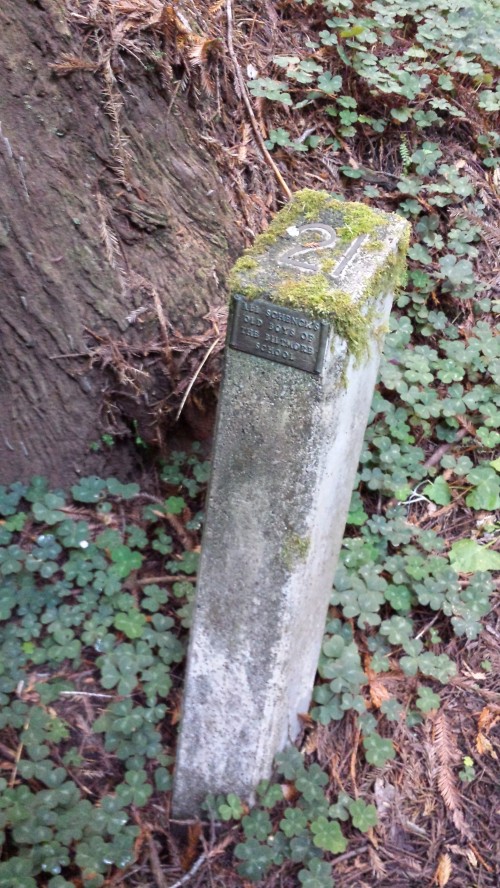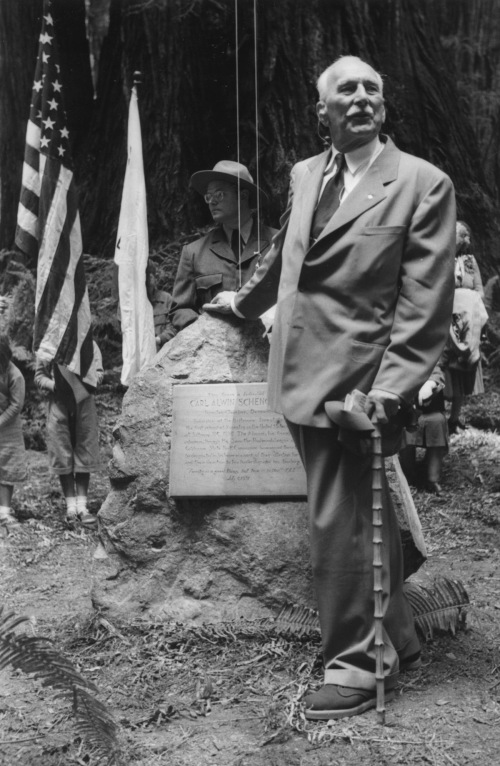A Visit to the Carl Alwin Schenck Redwood Grove
The silence, once I recognized it, struck me as odd, but then it made sense. I’ve been in louder empty churches, an apt analogy because I was here to pay my respects to the late, great man. I stood alone in the natural cathedral. The giant trees reminded me of the Corinthian columns that supported the roof of my childhood church—too big to wrap my arms around and requiring that I tilt my head all the way back to see the decorative capital of flowers and leaves. The top of the coastal redwoods and giant sequoias have their own version. I moved about the trail of marked trees silently so as not to disturb the named sentinels that guard the grove. It seemed silly because I was alone but it made all the sense in the world because of the reverence I feel for those honored here: Olmsted, Sargent, Vanderbilt, Pinchot, Fernow, and sixteen other founding fathers of the American forestry movement. They are the men that I have shared my life with, for a quarter of a century now, having spent countless hours studying, questioning, challenging, and arguing with and about them. But I had come to pay tribute to the man for whom the redwood grove is named and who had selected the trees that bore their names: Carl Alwin Schenck.
How is it that a redwood grove in northern California is named for a German forester who had barely stepped foot in these woods until he came here on July 4, 1951, for the dedication ceremony in his honor? He would have told you the answer is “love.” The love Schenck’s former students felt for him, and he them. Schenck’s saying that “Forestry is a good thing but love is better” is inscribed on the commemorative marker. Actually it tells us that “the alumni, his friends and admirers . . . have caused these trees to be designated in his honor as a mark of their affection for him and their devotion to his leadership and his teaching.” In mid-20th century America “affection” was an acceptable term for men to use when saying they loved one another. The word really harkened back to their youth, when they trailed through the forest behind Schenck like so many flannelled fledglings. But the inclusion of Schenck’s quotation tells you it was more than affection. “Affection” stands for many other things: “admiration,” “respect,” “friendship.” But most of all “love.”
“Have caused these trees” is an interesting choice of language. They—the alumni, “his boys” as he called them—had been his cause while he was their teacher. He taught them forestry, for sure, but taught them to be men, to drink beer around the campfire, and to drink deeply from the well of life. To know the great philosophers and the Bible. To know their oaks from their maples. To know that good forestry meant good roads. They in turn had made him their cause, to bring him back to the United States following World War II, to show him that they had become the men he expected them to be and had done the great things he prepared them to do. The last tree named is in their honor: “All Schenck’s Old Boys of The Biltmore School.”

***
The Carl Alwin Schenck Grove is in Prairie Creek Redwoods State Park in northern California. It's named for Dr. Carl Alwin Schenck (1868–1955), the chief forester of the Biltmore Estate in Asheville, North Carolina, and founder of the Biltmore Forest School, the first school of forestry in North America (1898–1913). The grove was dedicated on July 4, 1951, by Schenck in a ceremony attended by his former students, friends, and local dignitaries.
Schenck operated the school from 1898 to 1909 on the estate before he was dismissed by the owner, George Vanderbilt. Schenck then spent the next four years traveling with his students throughout the United States and Europe examining working fields and lumber operations before shuttering the school and returning to his native Germany by 1914. One of the many honors bestowed upon Schenck for his pioneering work in American forestry was having a grove named for him through a program operated by the Save-the-Redwoods League and the California State Park Commission.
The event was just one of several stops on a grand tour of the United States in 1951. The tour, sponsored by the American Forestry Association (now American Forests) and the school alumni, is captured in a limited edition book Trees for the Great: Honoring Carl Alwin Schenck. The book includes a phonograph recording recreating the redwood grove ceremony, complete with songs performed at the event and Dr. Schenck giving his speech in which he lists those he wished to honor with named trees. (You can listen to the mp3 version of it here.) It also includes reprints of articles from Newsweek magazine and The New Yorker Magazine.
The grove has two trail loops with numbered markers bearing the names of founders of the American forestry movement as selected by Schenck and one dedicated to his former students. Markers are still visible for (in sequential order) Frederick Law Olmsted Sr., Charles Sprague Sargent, George W. Vanderbilt, Gifford Pinchot, Sir Dietrich Brandis, Carl Schurz, John Sterling Morton, John Aston Warder, Nathaniel Egleston, Bernhard Fernow, Joseph T. Rothrock, Filibert Roth, Samuel B. Green, Dr. Homer D. House, and Dr. Clifford Durant Howe. (House and Howe taught at the Biltmore School.) Five markers are missing. It is hard to determine what names they bore because of some discrepancies between the names recorded at the time Schenck announced them in 1951 and the standing markers. The Save the Redwoods League is in the process of digitizing all their files relating to their many memorial groves.
The grove is located off the Newton B. Drury Scenic Parkway, approximately 8 miles north of Orick, California, off U.S. Highway 101. To reach the grove, park on the road at the Brown Creek Trail trailhead. Begin the 1.3-mile walk by going 0.2 miles east on the groomed dirt path to the trail junction. Turn left (north), staying on Brown Creek Trail and heading away from South Fork Trail. The footbridge to Schenck Grove is about 1.1 miles north of the junction. At the other side of the bridge sits the marker unveiled at the dedication. Allow at least three hours total to hike there and back and for exploring the grove.

"CAS" indicates the location of the Schenck Grove. "FLO" is the Frederick Law Olmsted Grove. The map is from the "Trail Map of Redwood National and State Parks" (Redwood Hikes Press, 2013)

Just on the other side of the bridge in Schenck Grove on the left you'll find the marker and where the ceremony took place in 1951.

The marker was dramatically lit by the sun when I arrived, as if Dr. Schenck wanted to make sure I didn't miss it. Click the photo so you can read the inscription.

Though the path is easy to walk, markers are subject to the whims of nature such as plant growth or fallen trees. The marker for the "Old Boys of The Biltmore School" is in the foreground.

Dr. Schenck at the marker after its unveiling. The tablet appears to be made of wood. The one there today is made of metal (see above).

Dr. Schenck delivering his speech as some former students and dignitaries listen.

